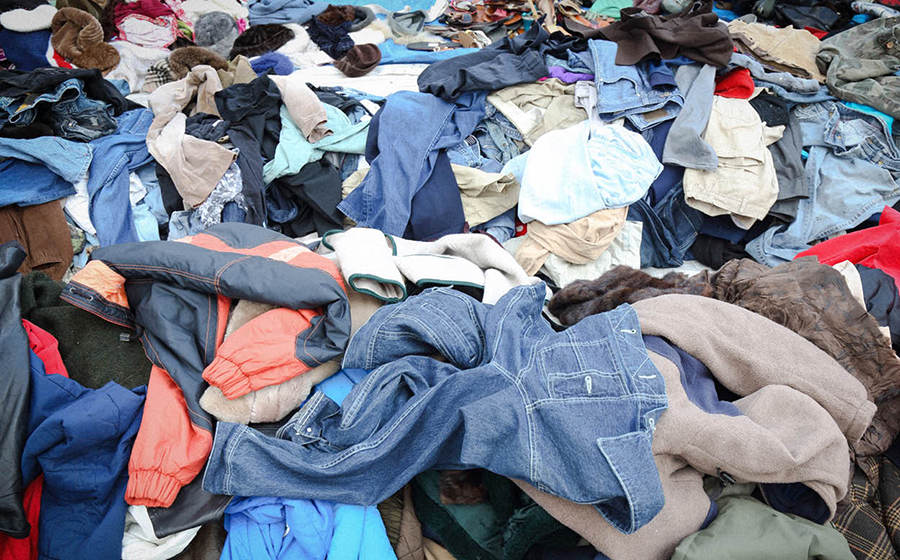Pick up almost any textile or apparel industry publication and you will be inundated with claims by apparel producers, brands and retailers about joining in or initiating their own high-profile efforts to address the issue of environmental sustainability. There is good reason to do so, as the impact of the manufacturing industry on the environment is bad — and getting worse. Despite the growing list of big brands and retailers who say they are taking up the fight, there appears to be little or no tangible progress, especially in light of the increasing amount of clothing being thrown into landfills every year.
Why is that? For the most part, brands and retailers are just paying lip service to textile and apparel environmental sustainability, and cynically, why wouldn\’t they? To address this issue in a meaningful way requires substantially higher costs for sustainable practices and more importantly, selling a lot less clothing! That is not something they will do voluntarily unless consumers force them to. Metaphorically, it will require consumers to declare war on brands and retailers who are not committed to, and are validated in, supporting sustainability. The threat of this values war is that customers will stop buying their goods, period. This will drive fear, which is the principal motivator that will drive immediate action.
Ambiguity
When you cut through all the green washing noise of organic cotton and recycled water bottles, it is clear that the single most important thing that can happen to make significant change is for people to buy a lot less clothing and to wear it a whole lot longer. That\’s the last thing most brands and retailers want to hear, let alone promote. As long as consumers continue to buy and throw away more and more clothing in the name of fast fashion, brands and retailers will continue to promote and feed that addiction, all the while \”signing\” onto numerous environmental efforts to appease those customers that care about sustainability. Until consumers demand well-made and more durable products, and refuse to buy cheaply made, disposable clothing, brands and retailers will have no incentive to do anything except adopt feel-good, marginally effective initiatives which give the appearance of taking action while really having little or no positive effect.
State of the Industry
Let\’s take a look, first at the problems. Significant environmental issues span the supply chain.
- Cotton growing uses enormous amounts of water and chemicals.
- Polyester consumes petrochemicals and is energy intensive to produce.
- The dyes and chemicals used for dyeing yarn, fabric and clothing are sometimes dumped onto land and into rivers.
- Microfibers released during clothes washing make up as much as 35 percent of the plastics we are finding in our oceans and waterways.
- And finally, we are buying more clothes and throwing them away more quickly than ever before. Landfills are being inundated with clothing, and much of it is polyester or other petrochemical-based synthetic fiber which breaks down over hundreds of years and leaves toxic chemicals and metals like antimony in the environment.
When you consider these problems, combined with the growing middle class in many developing countries who will most likely buy and dispose of more apparel, it\’s clear all these challenges will only intensify.
So, what is being done to address these issues? In my opinion, unfortunately, the old adage that \”when all is said and done, more will be said than done\” rings true. There are many well-meaning organizations and companies, some of which are very well funded, whose mission is to improve the environmental impact of the textile and apparel industries. Some focus on just one issue while others take a more industry-wide approach. The one commonality I have seen so far is very little measurable impact from any of their efforts.
A New Economic Model
Why is real improvement so elusive? The Ellen MacArthur Foundation is one organization that is trying to address these problems in an industry wide and disciplined way. In March 2018 at the Copenhagen Fashion Summit, the Foundation and some big names in fashion and apparel announced they were joining forces to create an apparel industry manifesto based on the principles of a circular economy. \”Make Fashion Circular\” core partners are H&M, Burberry, Gap Inc., HSBC, Nike and Stella McCartney. Other participants include DuPont, Lenzing, and VF, and unites other well-known fashion designers, producers, and brands along with government authorities, NGO\’s and innovators to deliver sustainable improvement based on three key principles:
- Business models that keep clothes in use.
- Materials that are renewable and safe.
- Solutions that turn used clothes into new clothes.
The stated belief is the fashion industry can capture $460 billion currently lost due to single use of clothing. But what does that really mean? The answer comes from the Ellen MacArthur Foundation report \”A New Textiles Economy: Redesigning Fashion\’s Future. Calculation of $460 billion is based on \”Circular Fibers initiative materials flow analysis and Euromonitor International Apparel and Footwear 2016 Edition (volume sales trends 2005-2015). In 2015, 46% (in mass) of collected garments were reused. If 100% of discarded clothing were collected, 22.2 million tonnes would be reused instead of 5.6 million tonnes as at present, meaning 16.6 million tonnes of new garment sales would be avoided, with a value of USD 460 billion.\”
Reality Check
So, the message is some very large players in the textile and apparel industry, which has annual global industry revenues of about $1.3 trillion, are signing on to an effort to eliminate about 35 percent of industry sales to make the industry more environmentally sustainable. I ran a public company for many years and I wouldn\’t want to try to explain the rationale for that to my Board or shareholders. Makes one wonder if H&M and The Gap read the fine print. Or perhaps their participation is just a marketing ploy to tout their sustainability bona fides while doing little to truly address the real issue. In any case, it is hard to foresee success of this effort when many of the core partners apparently have a large monetary interest in mission failure.
Emerging Initiatives
That being said, there are emerging targeted brand-specific initiatives throughout the industry aimed at addressing one or a few of the issues I cited. Many are potentially major improvements that have to be scaled significantly to have a real impact. Here are a few examples. There are any more.
- H&M started an initiative in 2013 to collect used H&M clothing at all their retail outlets and works with I:CO, a global recycling company, to either reuse or repurpose the clothing as rags, insulation or back into fiber. An article from Public Radio International, titled \”How Good is H&M\’s Clothing Recycling Program?\” offers some insight into the success of this program. In summary, even though H&M provides incentives for customers to return their used clothing, it appears less than two percent of the clothing they sell is returned. Not much of an impact, though H&M promotes this program aggressively. Catarina Midby, Sustainability Manager at H&M UK and Ireland states \”You could always argue that, of course, in order to be really sustainable, you should cut down on your consumption, but at the same time we are a fashion company and we don\’t really want to compromise fashion for sustainability. But I don\’t think you have to these days.\” It\’s not difficult to read between the lines in that quote. I will give her credit, however, at least she\’s being honest.
- Unifi\’s Repreve® yarns are made from recycled plastic bottles and reduces petrochemical consumption and delays plastic bottles being put into the landfill for a short time until the clothing is discarded.
- Cotton Inc.\’s supports reducing water and chemical use in growing cotton.
- Parkdale\’s JV with Intrinsic Textiles produce CiClo® biodegradable polyester yarns.
It is encouraging that many companies and organizations are at least starting to work on mitigating the negative effects of textile and apparel production, use and disposal. However, I am afraid many of those efforts today are too small or insincere to have a meaningful impact on a problem that is already so large and growing so quickly. Eradicating the problems will take bold and fundamental changes to the industry. Again, I don\’t believe the industry will make those kinds of changes unless consumers demand and are willing to pay for it.
Behavior Modification
A good place to start is to simply stop making and buying so damn much clothing. If we could actually do that, all of the issues, from petrochemical use to filling up landfills, would be mitigated. The fast- fashion obsession and culture of disposable clothing will have to end. Consumers will have to consider the cost-per-wear versus the cost-per-garment to understand and measure value, quality and durability.
I honestly don\’t believe companies like H&M and Old Navy are going to stop churning out cheap, practically disposable clothing for the sake of sustainability. I believe we must start educating consumers about the impact of their choices. To accomplish this, a broad and well-planned global education initiative is required. For instance, sustainability-focused non-profits like The Textile Exchange and The Ellen MacArthur Foundation, working with industry groups like The Sustainable Apparel Coalition need to develop and fund a global public service advertising campaign explaining the enormous environmental effects of apparel production and disposal, quantify the financial and ecological benefits of purchasing and continuing to wear high-quality and durable clothing, and identify ways to dispose of or repurpose that clothing in a sustainable and responsible manner.
Campaigns like this can work. We in the U.S. have made real progress in cleaning up our streets and highways over the last 50 years. It all started with the \”Keep America Beautiful\” program in the 1960s. Those of us old enough still remember the indelible image of a Native American elder shedding a tear while seeing trash littering our highways. Broad-based and effective public service advertising works if the message is powerful, purposeful and authentic. Consumers are the best viral marketers. Once they shun cheap and disposable fashion and embrace wearing well-made, durable and even shared clothing, they redefine what\’s truly fashionable. They will also be effective change agents when they demand the clothing they wear be made in a sustainable way. All told, their impetus will propel a truly circular economy for apparel.
New Markets
In a circular economy, producers and brands would have to produce and sell higher quality, more durable apparel. Those making and selling cheaply made, throw away fast-fashion trash will have to change or die. Demand for clothing swaps and second-use sales would grow and brands and retailers would have a new financial incentive to expand access beyond the few specialty resellers currently in place. The technology for recycling clothing, especially polyester, is commercially available, though processing is more expensive than using virgin materials. If consumers demand recycled clothing and are willing to pay a little more for it, the industry will invest and deliver. If consumers want clothing to be biodegradable when disposed of, technology like CiClo is available. Replacing polyester with a biodegradable substitute on a broad scale, requiring significant investment throughout the supply chain, could be very profitable to the companies willing to make that investment.
Fake News
Of course, once consumers demand and buy apparel that is responsibly produced from sustainable inputs, they will want to be assured they are actually getting what they are paying for. Some brands and retailers make sustainability claims they cannot back up. While I have personally seen many examples of this in the past, two stand out to me. In one case, several years ago, a large retailer claimed to be selling baby clothes made from 100 percent organic cotton. They sold extremely well. So much so that when one analyzed the volume they sold, it accounted for two to three times the amount of organic cotton grown globally at that time. In another case, a Unifi customer who had been purchasing Repreve® found and then began to use a cheaper imported recycled yarn. When a Unifi representative visited the customer\’s plant, he noticed the \”recycled\” yarn was being imported from an Indian producer who did not, at that time, make recycled yarns. As it turns out, an unscrupulous importer was relabeling virgin yarns as recycled. At Unifi, we had our recycled inputs and processes certified by a reputable and independent third party. We also included a chemical tracer in our Repreve® yarns which helped assure brands and retailers promoting use of Repreve® were actually using it. I believe that type of assurance will be required to deter the \”eco-cheating\” some will invariably be tempted to do.
Only Change Endures
In summary, to truly address the growing negative environmental impact of the textile and apparel industries, fundamental, wide-ranging and expensive structural changes will have to be made. Just delaying a plastic bottle\’s disposal into a landfill by a single use isn\’t going to make that much of a difference. The industry will not make meaningful changes to their business model for the sake of the environment, but they will if consumers demand it by \”shutting down\” those brands that do not commit to the necessary change.





